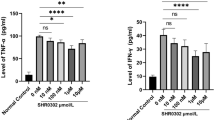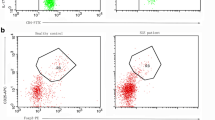Abstract
It has been well recognized that a deficit of numbers and function of CD4+CD25+Foxp3+ cells (Treg) is attributed to the development of some autoimmune diseases; however, there are controversial data regarding the suppressive effect of Treg cells on the T cell response in systemic lupus erythematosus (SLE). Additionally, IL-17-producing cells (Th17) have been recently emerged as a new pathogenic cell, but their role in lupus remains unclear. In this study, we studied the connection between Treg and Th17 cells in lupus patients. We observed that, while Treg or Th17 cells alone were not correlated to SLE development, the ratio of Treg to Th17 cells in active SLE patients is significantly lower than that in inactive SLE patients and healthy controls, and we also found corticosteroid treatment increased the ratio of Treg to Th17 cells in active SLE patients. Moreover, this ratio is inversely correlated with the severity of active SLE. The present study indicates that active SLE appears to exist as an imbalance between Treg and Th17 cells. Correction of this Treg/Th17 imbalance may have therapeutic impact for patients with SLE.






Similar content being viewed by others
References
Gottlieb AB, Lahita RG, Chiorazzi N, Kunkel HG (1979) Immune function in systemic lupus erythematosus. Impairment of in vitro T-cell proliferation and in vivo antibody response to exogenous antigen. J Clin Invest 63:885–892
Kolowos W, Gaipl US, Voll RE, Frank C, Haas JP, Beyer TD, Kalden JR, Herrmann M (2001) CD4 positive peripheral T cells from patients with systemic lupus erythematosus (SLE) are clonally expanded. Lupus 10:321–331
Reiner SL (2007) Development in motion: helper T cell at work. Cell 129:33–36
Mosmann TR, Coffman RL (1989) Th1 and Th2 cells: different patterns of lymphokine secretion lead to different functional properties. Annu Rev Immunol 7:145–173
Coffman RL (2006) Origins of the Th1-Th2 model: a personal perspective. Nat Immunol 7:539–541
Sakaguchi S (2000) Regulatory T cells: key controllers of immunologic self-tolerance. Cell 101:455–458
Sakaguchi S (2005) Naturally arising Foxp3-expressing CD25+CD4+ regulatory T cells in immunological tolerance to self and non-self. Nat Immunol 6:345–352
Harrington LE, Hatton RD, Mangan PR, Turner H, Murphy TL, Murphy KM, Weaver CT (2005) Interleukin 17-producing CD4+ effector T cells develop via a lineage distinct from the T helper type 1 and 2 lineages. Nat Immunol 6:1123–1132
Park H, Li XO, Yang SH, Chang SH, Nurieva R, Wang YH, Wang Y, Hood L, Zhu Z, Tian Q, Dong C (2005) A distinct lineage of CD4+ T cells regulates tissue inflammation by producing interleukin 17. Nat Immunol 6:1133–1141
Liu MF, Wang LL, Wu F (2004) Decreased CD4+CD25+ T cells in peripheral blood of patients with systemic lupus erythematosus. Scan J Immunol 59:198–202
Crispin JC, Martinez A, Alcocer-Varela J (2003) Quantification of regulatory T cells in patients with systemic lupus erythematosus. J Autoimmun 21:273–276
Miyara M, Amoura Z, Parizot C, Badoual C, Dorgham K, Trad S, Nochy D, Debré P, Piette JC, Gorochov G (2005) Global natural regulatory T cell depletion in active systemic lupus erythematosus. J Immunol 175:8392–8400
Valencia X, Yarboro C, Illei G, Lipsky PE (2007) Deficient CD4+CD25high T regulatory cell function in patients with active systemic lupus erythematosus. J Immunol 178:2579–2588
Mellor-Pita S, Citores MJ, Castejon R, Tutor-Ureta P, Yebra-Bango M, Andreu JL, Vargas JA (2006) Decrease of regulatory T cells in patients with systemic lupus erythematosus. Ann Rheum Dis 65:553–554
Alvarado-Sánchez B, Hernández-Castro B, Portales-Pérez D, Baranda L, Layseca-Espinosa E, Abud-Mendoza C, Cubillas-Tejeda AC, González-Amaro R (2006) Regulatory T cells in patients with systemic lupus erythematosus. J Autoimmun 27:110–118
Kebir H, Kreymborg K, Ifergan I, Dodelet-Devillers A, Cayrol R, Bernard M, Giuliani F, Arbour N, Becher B, Prat A (2007) Human Th17 lymphocytes promote blood-brain barrier disruption and central nervous system inflammation. Nat Med 13:1173–1175
Aarvak T, Chabaud M, Miossec P, Natvig JB (1999) IL-17 is produced by some proinflammatory Th1/Th0 cells but not by Th2 cells. J Immunol 162:1246–1251
van Beelen AJ, Teunissen MB, Kapsenberg ML, de Jong EC (2007) Interleukin-17 in inflammatory skin disorders. Curr Opin Allergy Clin Immunol 7:374–381
Bettelli E, Oukka M, Kuchroo VK (2007) Th17 cells in the circle of immunity and autoimmunity. Nat Immunol 8:345–350
Masi AT, McShane DJ, Rothfield NF, Schaller JG, Talal N, Winchester RJ (1982) The 1982 revised criteria for the classification of systemic lupus erythematosus. Arthritis Rheum 25:1271–1277
Bombardier C, Gladman DD, Urowitz MB, Caron D, Chang CH (1992) Derivation of the SLEDAI. A disease activity index for lupus patients. The Committee on Prognosis Studies in SLE. Arthritis Rheum 35:630–640
Baecher-Allan C, Brown JA, Freeman GJ, Hafler DA (2001) CD4+CD25high regulatory cells in human peripheral blood. J Immunol 167:1245–1253
Liu WH, Putnam AL, Xu-Yu Z, Szot GL, Lee MR, Zhu S, Gottlieb PA, Kapranov P, Gingeras TR, Fazekas de St Groth B, Groth B, Clayberger C, Soper DM, Ziegler SF, Bluestone JA (2006) CD127 expression inversely correlates with FoxP3 and suppressive function of human CD4+ Treg cells. J Exp Med 203:1701–1711
Seddiki N, Santner-Nanan B, Martinson J, Zaunders J, Sasson S, Landay A, Solomon M, Selby W, Alexander SI, Nanan R, Kelleher A, Fazekas de St Groth B (2006) Expression of interleukin (IL)-2 and IL-7 receptors discriminates between human regulatory and activated T cells. J Exp Med 203:1693–1700
Nguyen XD, Robinson DS (2004) Fluticasone propionate increases CD4+CD25+ T regulatory cell suppression of allergen-stimulated CD4+CD25+ T cells by an IL-10-dependent mechanism. J Allergy Clin Immunol 114:296–301
Karagiannidis C, Akdis M, Holopainen P, Woolley NJ, Hense G, Rückert B, Mantel PY, Menz G, Akdis CA, Blaser K, Schmidt-Weber CB (2004) Glucocorticoids upregulate FOXP3 expression and regulatory T cells in asthma. J Allergy Clin Immunol 114:1425–1433
Azab NA, Bassyouni IH, Emad Y, Abd El-Wahab GA, Hamdy G, Mashahit MA (2008) CD4+CD25+ regulatory T cells (TREG) in systemic lupus erythematosus (SLE) patients: the possible influence of treatment with corticosteroids. Clin Immunol 127:151–157
Ivanov II, McKenzie BS, Zhou L, Tadokoro CE, Lepelley A, Lafaille JJ, Cua DJ, Littman DR (2006) The orphan nuclear receptor RORγt directs the differentiation program of proinflammatory IL-17+ T helper cells. Cell 126:1121–1133
Gambineri E, Torgerson TR, Ochs HD (2003) Immune dysregulation, polyendocrinopathy, enteropathy, and X-linked inheritance (IPEX), a syndrome of systemic autoimmunity caused by mutations of FOXP3, a critical regulator of T-cell homeostasis. Curr Opin Rheumatol 15:430–435
Khattri R, Cox T, Yasayko SA, Ramsdell F (2003) An essential role for Scurfin in CD4+CD25+ T regulatory cells. Nat Immunol 4:337–342
Hori S, Nomura T, Sakaguchi S (2003) Control of regulatory T cell development by the transcription factor Foxp3. Science 299:1057–1061
Lin SC, Chen KH, Lin CH, Kuo CC, Ling QD, Chan CH (2007) The quantitative analysis of peripheral blood FOXP3-expressing T cells in systemic lupus erythematosus and rheumatoid arthritis patients. Eur J Clin Investig 37:987–996
Bonelli M, von Dalwigk K, Savitskaya A, Smolen JS, Scheinecker C (2008) Foxp3 expression in CD4+ T cells of patients with systemic lupus erythematosus (SLE): a comparative phenotypic analysis. Ann Rheum Dis 67:664–671
Pillai V, Ortega SB, Wang CK, Karandikar NJ (2007) Transient regulatory T-cells: a state attained by all activated human T-cells. Clin Immunol 123:18–29
Wang J, Ioan-Facsinay A, van der Voort EI, Huizinga TW, Toes RE (2007) Transient expression of FOXP3 in human activated nonregulatory CD4+ T cells. Eur J Immunol 37:129–138
Monk CR, Spachidou M, Rovis F, Leung E, Botto M, Lechler RI, Garden OA (2005) MRL/Mp CD4+ CD25− T cells show reduced sensitivity to suppression by CD4−CD25− regulatory T cells in vitro. A novel defect of T Cell regulation in systemic lupus erythematosus. Arthritis Rheum 52:1180–1184
Baráth S, Soltész P, Kiss E, Aleksza M, Zeher M, Szegedi G, Sipka S (2007) The severity of systemic lupus erythematosus negatively correlates with the increasing number of CD4(+)CD25(high)FoxP3(+) regulatory T cells during repeated plasmapheresis treatments of patients. Autoimmunity 40:521–528
Wong CK, Ho CY, Li EK, Lam CW (2000) Elevation of proinflammatory cytokine (IL-18, IL-17, IL-12) and Th2 cytokine (IL-4) concentrations in patients with systemic lupus erythematosus. Lupus 9:589–593
Kang HK, Liu M, Datta SK (2007) Low-dose peptide tolerance therapy of lupus generates plasmacytoid dendritic cells that cause expansion of autoantigen-specific regulatory T cells and contraction of inflammatory Th17 cells. J Immunol 178:7849–7858
Fantini M, Becker C, Monteleone G, Pallone F, Galle PR, Neurath MF (2004) Cutting edge: TGF-β induces a regulatory phenotype in CD4+CD25− T cells through foxp3 induction and down regulation of Smad7. J Immunol 172:5149–5153
Bettelli E, Carrier Y, Gao W, Korn T, Strom TB, Oukka M, Weiner HL, Kuchroo VK (2006) Reciprocal developmental pathways for the generation of pathogenic effector Th17 and regulatory T cells. Nature 441:235–238
Wan S, Xia C, Morel L (2007) IL-6 produced by dendritic cells from lupus-prone mice inhibits CD4+ CD25+ T cell regulatory functions. J Immunol 178:271–279
Tackey E, Lipsky PE, Illei GG (2004) Rationale for interleukin-6 blockade in systemic lupus erythematosus. Lupus 13:339–343
Zheng SG, Wang J, Wang P, Gray JD, Horwitz DA (2007) IL-2 is essential for TGF-β to convert naïve CD4+CD25− cells to CD25+Foxp3+ regulatory T cells and for expansion of these cells. J Immunol 178:2018–2027
Furtado GC, Curotto de Lafaille MA, Kutchukhidze N, Lafaille JJ (2002) Interleukin 2 signaling is required for CD4+ regulatory T cell function. J Exp Med 196:851–857
Setoguchi R, Hori S, Takahashi T, Sakaguchi S (2005) Homeostatic maintenance of natural Foxp3+ CD25+CD4+ regulatory T cells by interleukin 2 and induction of autoimmune disease by IL-2 neutralization. J Exp Med 201:723–735
Kammer GM (2005) Altered regulation of IL-2 production in systemic lupus erythematosus: an evolving paradigm. J Clin Invest 115:836–840
Laurence A, Tato CM, Davidson TS, Kanno Y, Chen Z, Yao Z, Blank RB, Meylan F, Siegel R, Hennighausen L, Shevach EM, O'shea JJ (2007) Interleukin-2 signaling via STAT5 constrains T helper 17 cell generation. Immunity 26:371–381
Acknowledgments
This study was supported by grants from Zhejiang Provincial Natural Science Foundation of China (2090918, J.L.M.), the Health Bureau of Zhejiang Province (2007A162, J.L.M.), Hangzhou Science and Technology Bureau (20080333Q28, J.L.M.), and the fund of Hangzhou health administration (2006Z006, 2007B0047, J.L.M.), from James H. Zumberge Faculty Research and Innovation Fund, Arthritis Foundation, Outstanding Young Scientist Investigator Award from National Nature Science Foundation of China (30728007), and the American College of Rheumatology Research and Education’s Within Our Reach: Finding a Cure for Rheumatoid Arthritis campaign and Shanghai Pudong New Area Science and Technology Bureau (PKJ2009-Y41, S.G.Z).
Disclosures
None
Author information
Authors and Affiliations
Corresponding authors
Rights and permissions
About this article
Cite this article
Ma, J., Yu, J., Tao, X. et al. The imbalance between regulatory and IL-17-secreting CD4+ T cells in lupus patients. Clin Rheumatol 29, 1251–1258 (2010). https://doi.org/10.1007/s10067-010-1510-7
Received:
Revised:
Accepted:
Published:
Issue Date:
DOI: https://doi.org/10.1007/s10067-010-1510-7




